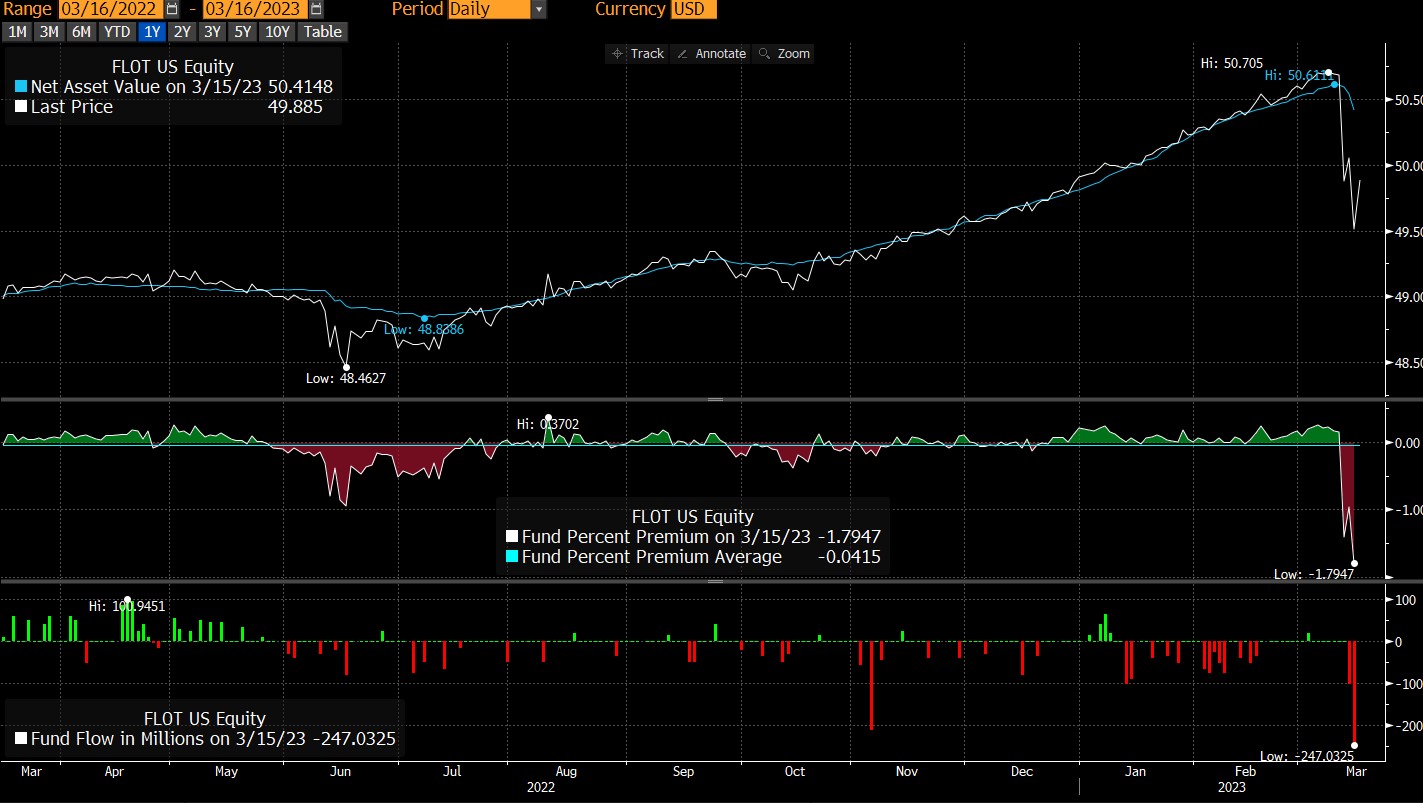Floating rate bond ETFs have gone from the ideal shelter from 40-year-high interest rate hikes to front-and-centre casualties of the banking sector volatility sparked by Silicon Valley Bank (SVB) and Credit Suisse last week.
Highlighting this, the $2.5bn iShares $ Floating Rate Bond UCITS ETF (FLOT) has seen $230m outflows and dropped 1.7% over the past week, as at 16 March, according to data from ETFLogic.
The $8bn US-listed FLOT fared even worse, however, booking $247m outflows in one day on 15 March while seeing its discount to its net asset value (NAV) widen to -1.79%.

Source: Bloomberg Intelligence
Recent instability followed a hawkish speech from Federal Reserve chair Jerome Powell and SVB’s share price crashing as its investments in long-duration mortgage-backed securities (MBS) fed into an asset-liability mismatch, liquidity issues and a run on the bank. Within two days, SVB collapsed entirely.
Credit Suisse saw its share dropped an additional 30% last week after confirming “material weaknesses” in its reporting and control procedures in recent years following a probe by the Securities and Exchange Commission (SEC).
Prior to the Swiss National Bank offering $51bn of support, Credit Suisse shares were also rocked by The Saudi National Bank refusing to continue offering financial backing and the broader knock-on effects of SVB’s collapse.
Credit Suisse shares were trading 97% down from all-time-highs last week ahead of the recent $3.25bn acquisition deal with UBS, while its credit default swaps (CDS) traded at their highest since 2008 and priced in a 40% likelihood of default.
BlackRock’s FLOT like most floating rate bond strategies has high exposure to banks, allocating 51% to investment grade bonds from issuers in the sector including 1.2% to Credit Suisse bonds alone.
Explaining the reason for this sector bias, Kamil Sudiyarov, product manager at VanEck, which also has a floating rate ETF in the US, told ETF Stream: “Floating rate bond ETFs rely on bank sector bonds as part of their interest rate hedging which is more important for banks from the balance sheet standpoint compared to other sectors.
“The SVB situation hit the financial industry and then everything that is related to it.”
Sudiyarov then explained why the events of the past fortnight have impacted the product class.
“You have two types of duration: interest rate duration which does not really affect floating rates and also spread duration. I can imagine the spreads really increased on all kinds of bonds.
“We also saw the rising price of credit default swaps for Credit Suisse which also meant that their bond prices were hit.”
Ironically, if some measure of banks’ recent instability owes to rising interest rates – such as SVB’s asset-liability mismatch – this could raise questions around whether overweighting banks works against floating rate bond ETFs’ purpose of hedging interest rate risk.
While banks can profit from the difference between the rate they borrow money and the rate they lend to clients, this is not the case when interest rates increase rapidly.
The fastest hiking cycle in four decades has led to the most inverted US Treasury yield curve since the 1980s. To fight inflation, the Fed has exposed potential cracks in the banking system and in turn pulled the rug out from beneath the mainstay of floating rate ETFs.
Campbell Harvey, the economist that coined the theory that inverted yield curves act as a bellwether for recession, recently said: “A positively sloped yield curve – long-term rates higher than short-term rates – is good for bank health because banks generally pay short-term rates (for savings deposits) and receive longer-term rates (on their loan book).
“In aggressively raising short rates, the Fed has upended the normal model. Other banks could be at risk. The Fed urgently needs to assess this possibility.”




